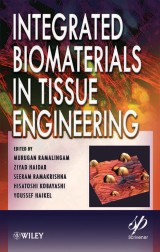Details

Integrated Biomaterials in Tissue Engineering
Biomedical Science, Engineering, and Technology, Band 4 1. Aufl.
|
164,99 € |
|
| Verlag: | Wiley |
| Format: | EPUB |
| Veröffentl.: | 02.04.2012 |
| ISBN/EAN: | 9781118371213 |
| Sprache: | englisch |
| Anzahl Seiten: | 328 |
DRM-geschütztes eBook, Sie benötigen z.B. Adobe Digital Editions und eine Adobe ID zum Lesen.
Beschreibungen
<p> </p> <p>This book acts as a self-contained resource for understanding the current technological advancement of biomaterials towards tissue engineering applications. It covers impact of biomaterials at different length scales such as macro/micro/nano/ level and offers extensive discussion on cell-biomaterial interactions with illustrative examples.</p> <p><br /> This resource offer a multi-disciplinary approach for the adaptability of integrated biomaterials in tissue repair and reconstruction.</p>
Preface xiii <p>1. Protocols for Biomaterial Scaffold Fabrication 1<br /> <i>Azadeh Seidi and Murugan Ramalingam</i></p> <p>1.1 Introduction 1</p> <p>1.2 Scaffolding Materials 4</p> <p>1.3 Techniques for Biomaterial Scaffolds Fabrication 7</p> <p>1.4 Summary 19</p> <p>Acknowledgements 20</p> <p>2. Ceramic Scaffolds, Current Issues and Future Trends 25<br /> <i>Seyed-Iman Roohani-Esfahani S. I. and Hala Zreiqat H.</i></p> <p>2.1 Introduction 25</p> <p>2.2 Essential Properties and Current Problems of Ceramic Scaffolds 27</p> <p>2.3 Approaches to Overcome Ceramic Scaffolds Issues for the Next Generation of Scaffolds 30</p> <p>2.4 Silk – a Bioactive Material 35</p> <p>Acknowledgements 36</p> <p>References 36</p> <p>3. Preparation of Porous Scaffolds from Ice Particulate Templates for Tissue Engineering 47<br /> <i>Guoping Chen and Naoki Kawazoe</i></p> <p>3.1 Introduction 48</p> <p>3.2 Preparation of Porous Scaffolds Using Ice Particulates as Porogens 48</p> <p>3.3 Preparation of Funnel-like Porous Scaffolds Using Embossed Ice Particulate Templates 51</p> <p>3.4 Application of Funnel-like Porous Scaffolds in Three-dimensional Cell Culture 56</p> <p>3.5 Application of Funnel-like Collagen Sponges in Cartilage Tissue Engineering 57</p> <p>3.6 Summary 60</p> <p>References 60</p> <p>4. Fabrication of Tissue Engineering Scaffolds 63<br /> <i>Naznin Sultana and Min Wang</i></p> <p>4.1 Introduction 64</p> <p>4.2 Materials for Tissue Engineering Scaffolds 65</p> <p>4.3 Fabrication Techniques for Tissue Engineering Scaffolds 68</p> <p>4.4 Fabrication of Pure Polymer Scaffolds via Emulsion Freezing/Freeze-drying and Characteristics of the Scaffolds 70</p> <p>4.5 Fabrication of Polymer Blend Scaffolds via Emulsion Freezing/Freeze-drying and Characteristics of the Scaffolds 78</p> <p>4.6 Fabrication of Nanocomposite Scaffolds via Emulsion Freezing/Freeze-drying and Characteristics of the Scaffolds 80</p> <p>4.7 Surface Modification for PHBV-based Scaffolds 85</p> <p>4.8 Concluding Remarks 87</p> <p>Acknowledgments 87</p> <p>References 88</p> <p>5. Electrospun Nanofiber and Stem Cells in Tissue Engineering 91<br /> <i>Susan Liao, Seeram Ramakrishna and Murugan Ramalingam</i></p> <p>5.1 Introduction 92</p> <p>5.2 Biodegradable Materials for Tissue Engineering 93</p> <p>5.3 Nanofibrous Scaffolds 97</p> <p>5.4 Stem Cells: A Potential Tool for Tissue Engineering 109</p> <p>5.5 Prospects 114</p> <p>Acknowledgement 116</p> <p>References 116</p> <p>6. Materials at the Interface Tissue-implant 121<br /> <i>Antonio Peramo</i></p> <p>6.1 Introduction 122</p> <p>6.2 Description of the Tissue-device Interface 123</p> <p>6.3 Expected Function of the Materials at the Interface and their Evaluation and Selection 125</p> <p>6.4 Experimental Techniques for the Tissue-implant Interface 132</p> <p>6.5 Conclusion 135</p> <p>References 135</p> <p>7. Mesenchymal Stem Cells in Tissue Regeneration 139<br /> <i>Kalpana S. Katti, Avinash A. Ambre, and Dinesh R. Katti</i></p> <p>7.1 Introduction 139</p> <p>7.2 Mesenchymal stem cells (MSCs) 144</p> <p>7.3 Understanding the Mesenchymal Stem Cells (MSCs) 149</p> <p>7.4 Mesenchymal Stem Cell (MSC) Culture 152</p> <p>7.5 Characterization of MSCs 155</p> <p>7.6 MSCs in Bone Remodeling, Fracture Repair and their Use in Bone Tissue Engineering Applications 158</p> <p>7.7 Influence of External Stimuli on MSC Behavior 159</p> <p>7.8 Perspectives on Future of hMSCs in Tissue Engineering 161</p> <p>References 162</p> <p>8. Endochondral Bone Tissue Engineering 167<br /> <i>Sanne K. Both, Fang Yang, and John A. Jansen</i></p> <p>8.1 Introduction 167</p> <p>8.2 Tissue Engineering and Stem Cells 171</p> <p>8.3 Scaffolds 175</p> <p>8.4 Summary 181</p> <p>References 182</p> <p>9. Principles, Applications, and Technology of Craniofacial Bone Engineering 185<br /> <i>Mona K. Marei, Mohamed A. Alkhodary, Rania M. Elbackly, Samer H. Zaky, Admed M. Eweida, Muhammad A. Gad, Maglaa Abdel-Wahed and Yasser M. Kahad</i></p> <p>9.1 Introduction 186</p> <p>9.2 Road Map for the Application of Tissue Engineering and Regenerative Medicine for Craniofacial Bone Regeneration 197</p> <p>9.3 Stem Cell-based Craniofacial Bone Engineering 201</p> <p>9.4 Biomaterial-based Therapy in Craniofacial Bone Engineering 208</p> <p>9.5 Principles of Imaging in Craniofacial Bone Regeneration 214</p> <p>9.6 Current Clinical Application and Future Direction in the Field of Craniofacial Bone Engineering 222</p> <p>9.7 Future Prospects 227</p> <p>9.8 Economics and Marketing 227</p> <p>9.9 Conclusions 228</p> <p>References 228</p> <p>10. Functionally-Graded Biomimetic Vascular Grafts for Enhanced Tissue Regeneration and Bio-integration 237<br /> <i>Vinoy Thomas and Yogesh K. Vohra</i></p> <p>10.1 Introduction 238</p> <p>10.2 Approaches in Vascular Tissue Engineering 239</p> <p>10.3 Nanostructured Scaffolds for Vascular Tissue Engineering 241</p> <p>10.4 Functionally-Graded Tubular Scaffolds 249</p> <p>10.5 Summary and Future Outlook 268</p> <p>Acknowledgements 269</p> <p>List of Abbreviations Used 270</p> <p>References 271</p> <p>11. Vascular Endothelial Growth Factors in Tissue Engineering: Challenges and Prospects for Therapeutic Angiogenesis 277<br /> <i>Ekaterina S. Lifirsu, Murugan Ramalingam, and Ziyad S. Haidar</i></p> <p>11.1 Introduction 278</p> <p>11.2 VEGF and Angiogenesis 278</p> <p>11.3 VEGF Family 279</p> <p>11.4 VEGF Therapy 281</p> <p>11.5 VEGF Delivery Systems 282</p> <p>11.6 Soft versus hard Tissues 284</p> <p>11.7 Concluding Remarks 289</p> <p>References 292 </p>
<p><strong>Murugan Ramalingam</strong>, University of Strasbourg, France and Tohoku University, Japan. <p><strong>Ziyad Haidar</strong>, Inha University, South Korea and University of Utah, USA. <p><strong>Seeram Ramakrishna</strong>, National University of Singapore, Singapore. <p><strong>Hisatoshi Kobayashi</strong>, National Institute for Materials Science, Japan. <p><strong>Youssef Haikel</strong>, University of Strasbourg, France.

















